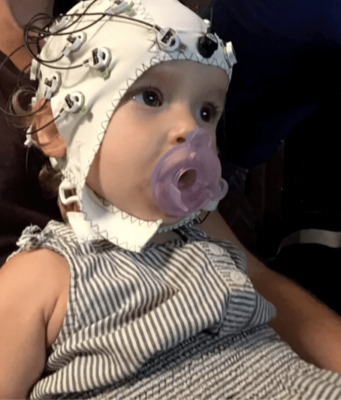Introduction 1
Pfeiffer Syndrome is a rare and complex genetic malformation significantly impacting craniofacial development. This intricate condition can pose substantial challenges in both its diagnosis and management. In this comprehensive exploration, we will navigate the intricacies of Pfeiffer Syndrome, from its genetic underpinnings to the array of clinical features it presents, the diagnostic complexities surrounding this condition, and the most recent advances in treating and managing this rare disorder.
Unraveling the Genetic Basis
Pfeiffer Syndrome is primarily driven by genetic mutations in the Fibroblast Growth Factor Receptor 1 (FGFR1) and Fibroblast Growth Factor Receptor 2 (FGFR2) genes. 2 These genes play pivotal roles in craniofacial development and the regulation of bone growth. It is these genetic mutations that set in motion the complex array of challenges experienced by individuals with Pfeiffer Syndrome. 1
Figure 1: Picture of a child with Type 1 Pfeiffer Syndrome, with an elevation of the eyes.
The genetic inheritance of Pfeiffer Syndrome is autosomal dominant, meaning that individuals who inherit even one copy of the mutated gene from either parent can develop the condition. This autosomal dominant pattern increases the likelihood of Pfeiffer Syndrome occurring within families with a history of the disorder. This unique genetic aspect influences not only the inheritance of the syndrome but also the complexities of its manifestation.2
Figure 2: Picture of a child with Type 2 Pfeiffer Syndrome, with a clover leaf skull and an elevation of the eyes.
The Clinical Landscape of Pfeiffer Syndrome 1,3
Craniosynostosis
A genetic condition that causes premature fusion of cranial sutures, leading to restricted skull expansion. It can result in cognitive and motor delays, vision and hearing problems, and other associated conditions. Early diagnosis and management are crucial for minimizing the impact on a child’s health and development.3
Distinctive Craniofacial Features
It is a disorder with various craniofacial abnormalities. The most noticeable features include:
- Bulging and widely spaced eyes.
- An underdeveloped midface.
- A beaked nose.
- A high-arched palate.
These distinct and characteristic facial features can pose social and psychological challenges for individuals affected by the condition. In addition to craniofacial abnormalities, Pfeiffer Syndrome can cause other physical abnormalities such as webbed fingers and toes, hearing loss, and developmental delays.
Limb Abnormalities
Pfeiffer Syndrome also impacts the development of bones in the skull, face, hands, and feet. It can cause craniofacial abnormalities, syndactyly (fusion of fingers or toes), and brachydactyly (short fingers or toes).
Diagnostic Challenges
Clinical Heterogeneity
This syndrome has three subtypes of varying severity that can be difficult to diagnose due to its clinical heterogeneity. Patients may present with various symptoms, leading to delayed or missed diagnoses. Symptoms include:
- Craniosynostosis (premature fusion of skull bones). 3
- Midface hypoplasia (underdevelopment of the middle of the face).
- Syndactyly (fusion of fingers or toes).
In severe cases, patients may also experience hydrocephalus (an accumulation of cerebrospinal fluid in the brain), hearing loss, and developmental delays. Due to the complexity of the syndrome and the range of symptoms that can present, a multidisciplinary team approach is often necessary to properly diagnose and manage Pfeiffer Syndrome. 1,3
Genetic Testing
Accurate diagnosis of Pfeiffer Syndrome requires molecular genetic testing, typically involving DNA sequencing to identify specific genetic mutations. This testing is crucial in confirming the diagnosis and determining the subtype of the syndrome. The subtype information can help physicians develop personalized treatment plans for underlying genetic mutations. Therefore, molecular genetic testing is an essential tool in managing patients with Pfeiffer Syndrome. 3
Management and Treatment 1
Craniofacial Surgery
Craniosynostosis is where an infant’s skull sutures fuse prematurely, causing developmental issues such as impaired brain growth. Early surgical intervention can create space for normal brain development. Craniofacial surgical techniques have advanced, resulting in more precise and effective interventions, leading to better long-term outcomes.
Orthopedic Care
Pfeiffer Syndrome causes limb abnormalities, typically requiring orthopedic care. To address joint fusions and improve limb mobility, individuals with Pfeiffer Syndrome often undergo a series of surgeries. These surgeries can vary in complexity and may involve joint separations, bone realignment, and soft tissue releases. With proper orthopedic care, many individuals with Pfeiffer Syndrome can achieve improved limb function and mobility.
Speech and Occupational Therapy
Limb abnormalities can pose challenges for motor skills. Physical and occupational therapy can help individuals adapt and improve muscle strength, coordination, range of motion, and balance, which are crucial for daily activities and overall well-being.
Psychological Support
Individuals with Pfeiffer Syndrome and their families may face social challenges due to facial differences. Seeking psychological support and counseling can help develop resilience, self-esteem, and provide a safe space to discuss emotional and mental health concerns. Additionally, it can help individuals accept and understand their unique features.
The Road to Hope 3
Genetic Research
Advancements in gene research have led to a deeper understanding of Pfeiffer Syndrome, improved diagnostic accuracy, and more targeted treatment approaches. Researchers have identified specific genetic mutations responsible for the syndrome, leading to more effective treatment options and significant improvements in care.
Supportive Communities
Supportive communities can be a valuable resource for families impacted by Pfeiffer Syndrome, a genetic disorder affecting skull growth. These networks offer access to specialized information, emotional support, and shared experiences, helping patients and their loved ones navigate this journey with greater ease and resilience.
Conclusion 1,2,3
Pfeiffer Syndrome, with its complex genetic underpinnings, poses unique challenges to affected individuals and their families. Understanding its genetic basis, clinical manifestations, and diagnostic intricacies is pivotal in managing this condition effectively. With the integration of surgical innovations, orthopedic care, and psychological support, individuals with Pfeiffer Syndrome can embark on a journey of resilience and hope, gradually navigating their way towards improved quality of life.
References
- Pfeiffer Syndrome – NORD (National Organization for Rare Disorders) [Internet]. NORD (National Organization for Rare Disorders). NORD; 2015. Available from: https://rarediseases.org/rare-diseases/pfeiffer-syndrome/
- Jay S, Wiberg A, Swan M, et al. The Fibroblast Growth Factor Receptor 2 p. A la172 P he Mutation in Pfeiffer Syndrome – History Repeating Itself. American Journal of Medical Genetics Part A. 2013 Mar 26;161(5):1158–63.
- Passos-Bueno MR, Sertié AL, Jehee FS, et al. Genetics of craniosynostosis: genes, syndromes, mutations and genotype-phenotype correlations. Front Oral Biol. 2008;12:107-143.
About Docquity
Docquity is an AI-based state-of-the-art private & secure continual learning network of verified doctors, bringing you real-time knowledge from thousands of doctors worldwide. Today, Docquity has over 400,000 doctors spread across six countries in Asia.
Meet experts and trusted peers across Asia where you can safely discuss clinical cases, get up-to-date insights from webinars and research journals, and earn CME/CPD credits through certified courses from Docquity Academy. All with the ease of a mobile app available on Android & iOS platforms!






